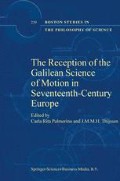Abstract
What causes ocean water to rise and fall between high tide and low tide levels twice a day at sea ports and shorelines? Over the course of the seventeenth century, European natural philosophers began to believe that the “flux and reflux of the sea” could be a very meaningful physical phenomenon. Their interest was stirred by the debate over Copernicus and the idea that the earth rotated on its own axis and orbited around the sun. The unsolved problem of the cause of the tides proved to be productive subject matter for Copernican and anti-Copernican authors alike. It was most productive of all, perhaps, for Galileo Galilei and Isaac Newton.
Access this chapter
Tax calculation will be finalised at checkout
Purchases are for personal use only
Preview
Unable to display preview. Download preview PDF.
References
Palmieri, “Re-examining Galileo’s Theory.”
Galilei, Dialogo [Gentile e.a. ] .
Paolo Rossi has described, for example, the astrological works of Francesco Patrizi (1591), wherein the rise and fall of the masses of ocean water in tidal flux and reflux were attributed to the influence and influx of natural heat from the sun and moon, and likened to the rise of water boiling in a pot. Rossi, Aspetti della rivoluzione scientifica, pp.17o-171.
Stevin, Principal Works [Crone e.a.], III, p. 333.
Cf. Pannekoek’s Summary of the Work in ibid., p. 328.
Copernicus, On the Revolutions [DobrzyckI e.a.], p. 15.
Ibid., p. 15.
Ibid., pp. 16–17.
Ibid., p. II6.
Drake, Galileo Studies, pp. 200–213. J. Renn, P. Damerow, S. Rieger, & D. Guilini have recently provided a much richer account of the discussions and collaborations between Galileo and Sarpi in the realm of mechanics and on the matter of the tides. See Renn e.a., “Hunting the White Elephant.”
Quoted in ibid., p. 201.
Ibid., pp. 201–202. Drake reports that paragraphs 569, 570, and 571, had earlier been published in Sarpi, Scritti.
Galilei, Dialogue [Drake], pp. 427–428.
Galilei, Le Opere [Favaro], vol. 2, p. 198.
There are many accounts and discussions of this exchange between Galileo and Kepler. Drake’s account may be found at Drake, Galileo at Work, pp. 40–42, for example.
Gilbert, De Magnete [Fleury Mottelay].
Gilbert, De Magnete [Fleury Mottelay], pp. 34o-341.
Ibid., p. 337.
Ibid., p. 334.
Kepler, Life and Letters [Baumgardt], pp. 43–45.
Kepler, New Astronomy [Donahue], pp. 55–56.
Kepler, Harmony of the World [Aition e.a. ] . Kepler’s remarks on the tides occur in Chapter Seven of Book Four, entitled “Epilogue on Sublunary Nature and on the Inferior Faculties of the Soul, Especially Those on which Astrology Depends.,
Galileo, ”Discorso del Flusso e Reflusso del Mare;’ in Le Opere [ Favaro ] , v, pp. 377–395. An English translation of the Discorso is found in Finocchiaro (ed.), The Galileo Affair, pp. 119–133.
Finocchiaro (ed.), The Galileo Affair, p. 120.
Bacon, ”On the Ebb and Flow?’ The interested reader should also see Paolo Rossi’s discussion of Bacon and Galileo on the tides in Rossi, Aspetti della rivoluzione scientifica.ca. pp.151–222.
Bacon, The New Organon [Anderson], bk. 2, aphorism 36, pp. 191–202, and aphorism 46, pp. 225–229.
Bacon, “On the Ebb and Flow,” p. 65.
Ibid. pp. 67, 69.
Ibid. p. 73.
Ibid., pp. 73, 75, 77.
Ibid., p. 87.
Ibid.
Ibid.
Ibid.
Rossi, Aspetti della rivoluzione scientifica, pp. 151–222.
Quoted by Drake, Galileo at Work, p. 274.
Bacon, The New Organon [Anderson], p. 227.
Galilei, Dialogue [Drake], pp. 446–447.
Ibid., p. 448.
Ibid., pp. 417–418.
Drake’s note to this passage tells us this prelate was Marcantonio de Dominis, whose work was Euripus sive sententia de fluxu et refluxu maris (Roma, 1624).
Drake’s note to this passage points out that this was the view of Galileo’s old professor of physics and medicine, Girolamo Borro, stated in Del Flusso e reflusso del mare e dell’inondatione del Nilo (Firenze, 1583).
Galilei, Dialogue [Drake], pp. 419–420.
Ibid., p. 420.
Ibid., pp. 432–433. 46 Ibid., p. 442.
Ibid., pp. 432–433.
Ibid., p. 442.
Ibid., p. 444.
Ibid., pp. 445–446.
Ibid., p. 447
Ibid., pp. 452–453.
Gassendi, Opera omnia, II, pp. 27–33.
Wallis, “Letter on the Flux and Reflux.”
Ibid., p. 265.
Ibid., p. 268.
Ibid.
Ibid., pp. 269–270.
Ibid., pp. 271–272.
Ibid., pp. 272–273.
Editor information
Editors and Affiliations
Rights and permissions
Copyright information
© 2004 Springer Science+Business Media Dordrecht
About this chapter
Cite this chapter
Hooper, W. (2004). Seventeenth-Century Theories of the Tides as a Gauge of Scientific Change. In: Palmerino, C.R., Thijssen, J.M.M.H. (eds) The Reception of the Galilean Science of Motion in Seventeenth-Century Europe. Boston Studies in the Philosophy of Science, vol 239. Springer, Dordrecht. https://doi.org/10.1007/978-1-4020-2455-9_11
Download citation
DOI: https://doi.org/10.1007/978-1-4020-2455-9_11
Publisher Name: Springer, Dordrecht
Print ISBN: 978-90-481-6658-9
Online ISBN: 978-1-4020-2455-9
eBook Packages: Springer Book Archive

